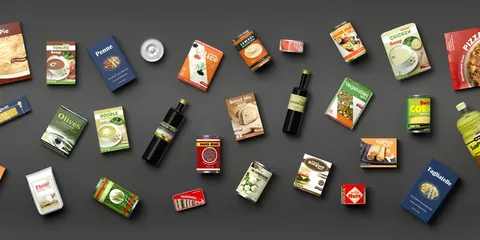In today’s fast-paced world, packaging plays a crucial role in shaping consumer experience and product usability. Among various packaging solutions, t
In today’s fast-paced world, packaging plays a crucial role in shaping consumer experience and product usability. Among various packaging solutions, tubed packaged goods have carved out a significant niche across numerous industries, including cosmetics, food, pharmaceuticals, and personal care. These goods, packaged in squeezable tubes, combine convenience, hygiene, and portability, making them a favorite choice for manufacturers and consumers alike.
spotlightlive
This article explores the concept of tubed packaged goods, their advantages, applications, materials used, trends, and challenges, along with frequently asked questions to provide a comprehensive understanding of this packaging format.
What Are Tubed Packaged Goods?
Tubed packaged goods refer to products contained within flexible or semi-rigid tubes, usually made from plastic, metal, or laminate materials. These tubes are designed to hold a wide range of viscous, semi-solid, or paste-like products, which consumers can easily dispense by squeezing the tube. The packaging often includes a nozzle or opening with a cap or flip-top lid to control product flow and maintain freshness.
Common products in tubed packaging include:
- Toothpaste
- Cosmetic creams and gels
- Adhesives like glue and epoxy
- Food pastes such as ketchup, mustard, and mayonnaise
- Pharmaceutical ointments and gels
The versatility and convenience of tubed packaging have made it an industry standard for numerous products requiring controlled dispensing.
Advantages of Tubed Packaged Goods
1. Convenience and Ease of Use
One of the primary benefits of tubed packaging is the ease with which consumers can use the product. The squeeze mechanism allows for controlled dispensing, reducing waste and mess. This is particularly important for products like toothpaste and creams, where hygiene and portion control are essential.
2. Portability
Tubes are lightweight and compact, making them easy to carry in bags or pockets. This portability makes tubed goods ideal for travel-sized personal care products and food condiments.
3. Product Protection
The sealed nature of tubes protects products from contamination, exposure to air, and moisture, thereby extending shelf life. Tubes also help prevent product degradation due to environmental factors such as light and oxygen.
4. Cost-Effectiveness
Tubed packaging is relatively inexpensive to manufacture, particularly plastic and laminate tubes. It also reduces transportation costs due to its lightweight and space-efficient design.
5. Sustainability Potential
With advances in materials, recyclable and biodegradable tubes are becoming more common, helping reduce environmental impact compared to bulk or rigid packaging options.

Materials Used in Tubed Packaging
The choice of material in tubed packaging depends largely on the product’s nature, shelf life requirements, and sustainability goals. Common materials include:
1. Plastic Tubes
Usually made from polyethylene (PE) or polypropylene (PP), plastic tubes are flexible, durable, and cost-effective. They are widely used for cosmetic creams, gels, and food products. Advances in multilayer laminates have enhanced barrier properties to protect sensitive ingredients.
2. Aluminum Tubes
Aluminum tubes provide excellent barrier protection against oxygen and light, making them ideal for pharmaceuticals and high-end cosmetic products. They are recyclable but less flexible than plastic tubes.
3. Laminated Tubes
These tubes combine layers of plastic, aluminum, and sometimes paper to offer a balance of flexibility and barrier protection. Laminated tubes are popular in cosmetics and pharmaceutical packaging for their protective qualities and printability.
Applications Across Industries
1. Cosmetics and Personal Care
Tubed packaging is extensively used for lotions, creams, gels, sunscreens, and hair care products. The hygienic dispensing and attractive design possibilities make tubes a preferred choice.
2. Food Industry
Ketchup, mustard, mayonnaise, and other condiments often come in tubes for easy application and portability. Tubed packaging also appears in bakery gels, icing, and ready-to-use sauces.
3. Pharmaceuticals
Medicinal ointments, topical creams, and gels benefit from tubed packaging, which ensures product integrity and precise dosing while maintaining sterility.
4. Industrial and Adhesives
Epoxy, glue, and other adhesives packaged in tubes offer convenient application and minimize product wastage.
Trends in Tubed Packaged Goods
1. Sustainable Packaging
Growing consumer awareness about environmental issues has pushed brands to adopt eco-friendly materials such as recycled plastics and biodegradable laminates.
2. Smart Packaging
Innovations such as tamper-evident seals, easy-to-open caps, and portion-control mechanisms are enhancing user experience.
3. Customization and Aesthetic Appeal
Brands are investing in creative designs and finishes, including matte, glossy, or soft-touch coatings, to stand out on shelves and attract consumers.
4. Refillable Tubes
To reduce waste, some companies are introducing refillable tube systems, especially in the cosmetics sector.
Challenges in Tubed Packaging
While tubed packaging offers many advantages, it also comes with challenges:
- Material Recycling: Multi-layer tubes are difficult to recycle due to their composite structure, although research is ongoing to improve this.
- Product Compatibility: Certain aggressive chemicals or solvents may react with tube materials, limiting their use.
- Manufacturing Complexity: Laminated and aluminum tubes require specialized machinery and quality control, which can raise production costs.
FAQs about Tubed Packaged Goods
Q1: What types of products are best suited for tubed packaging?
A: Products with viscous or semi-solid consistency such as creams, gels, ointments, adhesives, and food pastes are ideal for tubed packaging due to ease of dispensing and protection from contamination.
Q2: Are tubed packages recyclable?
A: Plastic tubes made from single polymers like polyethylene are recyclable, but multi-layered laminated tubes are more challenging to recycle. Aluminum tubes are recyclable but require proper collection and processing.
Q3: How does tubed packaging ensure product hygiene?
A: The sealed tube prevents contamination from air, dust, and bacteria. The dispensing nozzle minimizes contact between the product and external environment, maintaining hygiene.
Q4: Can tubed packaging extend product shelf life?
A: Yes. Tubes protect contents from exposure to light, oxygen, and moisture, all of which can degrade product quality over time.
Q5: What innovations are driving the future of tubed packaging?
A: Sustainable materials, smart dispensing caps, refillable tubes, and improved barrier technologies are shaping the future of tubed packaging to be more eco-friendly and user-centric.
Q6: Are aluminum tubes better than plastic tubes?
A: Aluminum tubes offer superior barrier protection but are less flexible and sometimes costlier to produce. Plastic tubes provide flexibility, are lighter, and often preferred for mass-market products.
Q7: How can consumers dispose of tubed packages responsibly?
A: Consumers should check local recycling guidelines. Single-material plastic tubes can be recycled where facilities exist, while aluminum tubes should be collected separately for metal recycling.
Conclusion
Tubed packaged goods have become an integral part of consumer product packaging, offering unmatched convenience, hygiene, and protection. Their adaptability across industries—from cosmetics to food and pharmaceuticals—underscores their value in modern packaging solutions. With ongoing innovations focused on sustainability and user experience, tubed packaging will continue to evolve, meeting both consumer demands and environmental responsibilities.
As consumers increasingly seek functional yet eco-friendly packaging, manufacturers must embrace new materials and designs that enhance recyclability without compromising product quality. This balance will be key to the continued success and growth of tubed packaged goods in the global market.
Must Visit: spotlightlive




COMMENTS